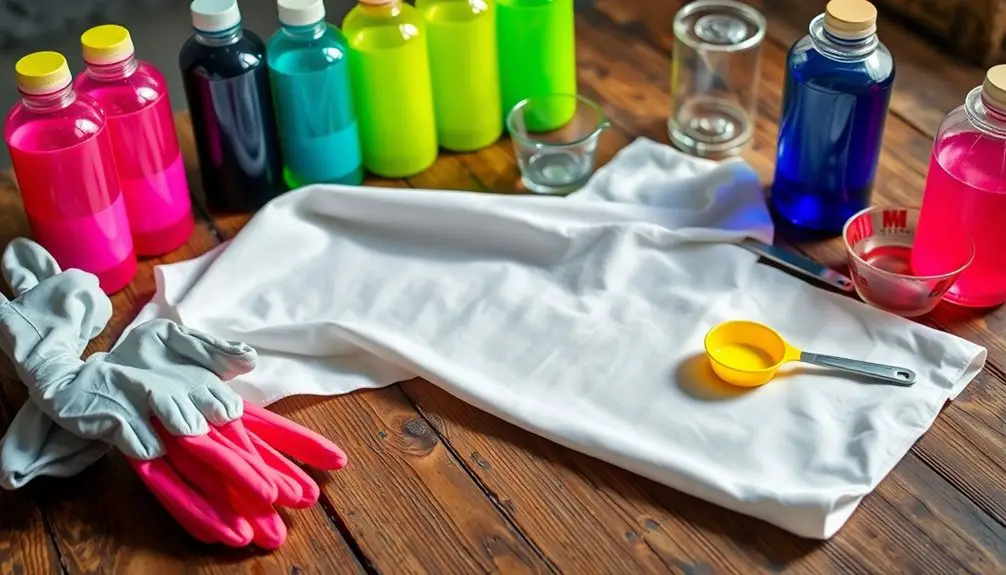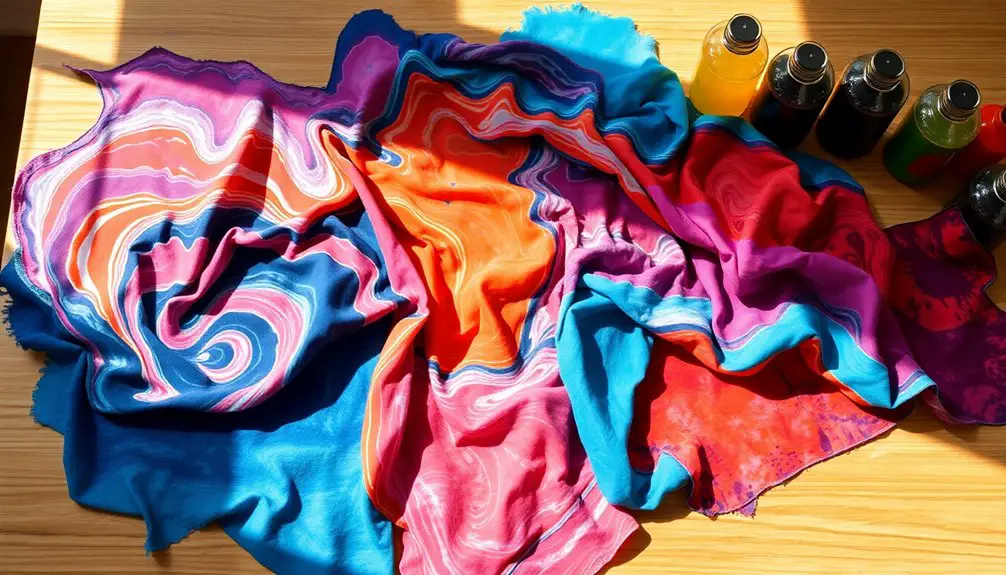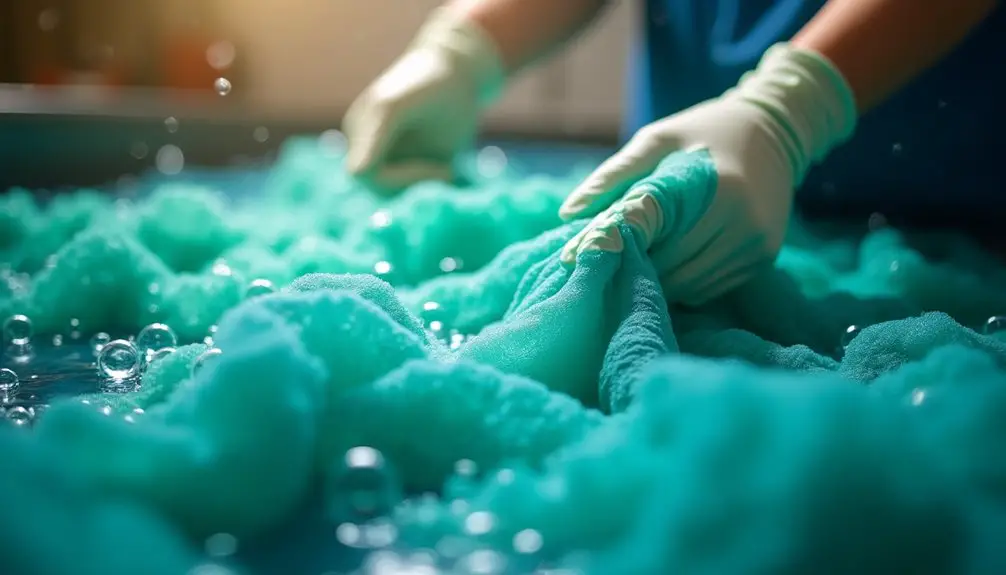Dyeing polypropylene fabric can be tricky due to its non-absorbent nature, but you can get great results with the right methods. Start by pre-washing your fabric with a mild detergent. Then, prepare a dye bath using Rit DyeMore specifically designed for synthetic fabrics. Heat 3 gallons of water per pound of fabric to a simmer and add the dye. Stir the fabric in the dye bath for 10 minutes to an hour, adjusting for your desired shade. For even better results, consider advanced techniques like chlorination or supercritical CO₂ dyeing. There's much more to explore to enhance your dyeing skills!
Key Takeaways
- Pre-wash polypropylene fabric with warm water and mild detergent to ensure optimal dye absorption.
- Use Rit DyeMore for synthetic fabrics, specifically designed for polypropylene dyeing.
- Maintain a dye bath temperature of 200°F (93°C) for effective coloration.
- Stir the fabric in the dye bath for 10 minutes to 1 hour to achieve the desired shade.
- Consider advanced methods like chlorination or supercritical CO2 for enhanced dyeability and environmental benefits.
Properties of Polypropylene Fabric
Polypropylene fabric stands out for its impressive combination of high tensile strength and low bulk density, making it both durable and lightweight. Its remarkable resistance to chemicals and rot enhances its longevity across various applications, such as upholstery, industrial textiles, outerwear, and apparel.
However, when it comes to dyeability to polypropylene, you'll face significant challenges due to the fabric's inherent non-textile nature. The crystallinity of polypropylene contributes to its hydrophobicity, making it difficult for dyes to penetrate uniformly. This limitation is particularly pronounced with unmodified polypropylene fibers, which struggle to bond with common dye types.
The dyeing process often requires specific conditions to encourage a chemical reaction that can facilitate better dye adherence. Unfortunately, even then, achieving reliable fastness properties remains a hurdle since the fabric's structure inherently resists standard dye applications.
While polypropylene's durability and lightweight nature make it a popular choice, its dyeability issues necessitate specialized techniques for effective coloration. Understanding these properties is crucial for anyone looking to work with polypropylene in applications where color and aesthetic appeal are essential.
Dyeing Techniques Overview
When it comes to dyeing polypropylene fabric, understanding the various techniques available is essential for achieving desirable results. Polypropylene's inherent hydrophobicity and high crystallinity can make dyeing a challenge, often leading to uneven coloration if you use unmodified fibers.
To enhance the dyeability of polypropylene, consider the Spin Coloration Method and physical modifications, like blending with dyeable polymers. These approaches improve heat stability and dispersibility, making the dyeing process more effective.
Chemical modifications, such as chlorination and graft copolymerization, introduce functional groups that enhance moisture regain and compatibility with various dye types, including acid and cationic dyes.
A standout method is supercritical CO2 dyeing, which not only eliminates wastewater production but also achieves superior dye uptake and wash fastness compared to traditional aqueous methods.
Each dyeing technique has its optimal conditions, with scCO2 dyeing showing significant improvements in fastness properties and color strength (K/S values).
Supplies and Preparation

To successfully dye polypropylene fabric, you'll need to gather essential supplies and prepare properly. Since polypropylene is a challenging material due to its chemical properties, it's crucial to use the right dye.
Here's a list of what you'll need:
- Rit DyeMore for synthetic fabrics: This new dye is specially formulated for polypropylene dyeable fabrics.
- Stainless steel pot: Use this for stovetop dyeing, ensuring it can hold about 3 gallons of water per pound of fabric.
- Dish detergent (1 tsp / 5 mL): This helps prepare the fabric by removing any residues that could hinder dye absorption.
- Rubber gloves and protective cover: Keep your hands safe and protect your work area from dye spills.
Before you start dyeing, pre-wash your garment to ensure it's clean and ready to absorb the dye.
Maintain a low temperature at around 200°F (93°C) during the dyeing process. After dyeing, be sure to rinse the fabric gradually in warm water until the waste water runs clear, and finish with a wash using mild detergent for the best results.
Step-by-Step Dyeing Instructions
Before diving into the dyeing process, it's essential to pre-wash your polypropylene fabric to eliminate any contaminants that could interfere with dye absorption. Follow these steps to achieve vibrant results using disperse dyes.
| Step | Action | Note |
|---|---|---|
| 1 | Pre-wash the fabric | Use warm water and mild detergent. |
| 2 | Prepare dye bath | Fill a pot with 3 gallons of water per pound of fabric. |
| 3 | Heat water | Maintain a low simmer at 200°F (93°C). |
| 4 | Add dye | Use Rit DyeMore, weighing fabric for accurate dye amount. |
| 5 | Stir fabric in dye bath | Keep submerged for 10 minutes to 1 hour for desired shade. |
Once you've achieved your desired color, rinse the fabric in warm water, gradually cooling it until the water runs clear. Lastly, wash the fabric with a mild detergent for best results. This method ensures effective dyeing polypropylene, resulting in a beautifully colored fabric ready for your next project.
Advanced Dyeing Methods and Innovations

Exploring advanced dyeing methods for polypropylene fabric reveals innovative techniques that enhance color vibrancy and durability. These methods can significantly improve the dyeing process, making it more efficient and eco-friendly.
Here are some cutting-edge techniques you should consider:
- Chlorination: This chemical modification increases polypropylene's dyeability by introducing functional groups, allowing better compatibility with various dyes.
- Graft Copolymerization: This technique enhances the mechanical properties and dye interaction by creating reactive sites on polypropylene, making it easier to bond with dyes.
- Azo Disperse Dyes: Recent studies show that azo thiazole dye derivatives offer high fastness properties, optimizing the dyeing process for polypropylene fabrics.
- Supercritical Carbon Dioxide (scCO₂): This eco-friendly method eliminates wastewater production, providing superior dye uptake compared to traditional aqueous methods.
Frequently Asked Questions
Can You Dye Polypropylene Fabric?
You can dye polypropylene fabric, but it's challenging. Its properties make traditional dyeing methods ineffective. To succeed, consider advanced techniques or chemical modifications to improve dye uptake and achieve the colors you want.
Which Dye Is Used for Polypropylene?
You can use specialized dyes like hydrazonopropanenitrile or cationic dyes on polypropylene. These options enhance the fabric's color uptake and ensure better results, making your dyeing process more effective and environmentally friendly.
Can Polypropylene Be Colored?
Yes, polypropylene can be colored, but it requires specific techniques due to its unique properties. Traditional dyeing methods often struggle, so exploring advanced approaches can help you achieve vibrant and lasting colors on this fabric.
How Do You Dye Poly Fiber?
To dye poly fiber, you'll need specialized methods since regular dyes won't work well. Consider using techniques like graft copolymerization or blend it with dyeable polymers for better results. Always test a swatch first.

